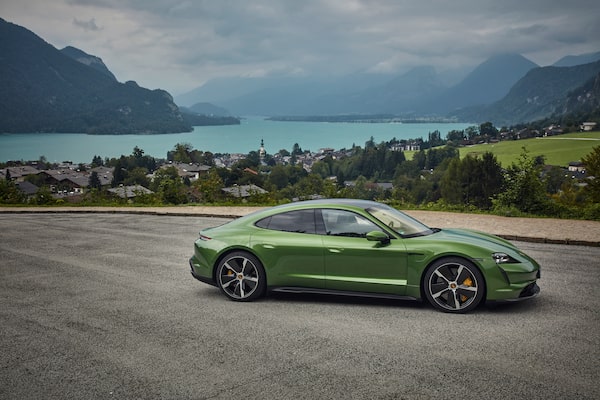
The Porsche Taycan is an electric car capable of remarkable acceleration.
Electric cars are so quick, they make me sick. If you’ve ever been on one of those vertical-drop rides at a theme park, Porsche’s electric Taycan accelerates just like that. You feel a sudden drop in the pit of your stomach. Nothing, then everything.
On a racetrack, which is the only place you can truly feel what this machine can do, it’s the mid-corner acceleration that’ll make you turn green. The sudden spike in lateral force when accelerating out of a turn is like being blindsided by a linebacker. Half an hour flat out in the Taycan was all my stomach could take.
You could blame my ragged driving, but doing lap after lap in the Porsche 718 Spyder – a minimalist two-seater powered only by exploding fuel and air – I could have kept going until there was no rubber left on the tires.
As necessary as the shift to electric cars has become – carbon emissions aren’t going to lower themselves – gearheads are going to lose out. When it comes to sports cars, especially on a racetrack, I’m sorry to say that internal combustion engines are still just better.
It’s not just the driving experience, either; it’s the little things. Going electric (or hydrogen) means saying goodbye to the intoxicating sound of a big V8 with a lumpy camshaft. It means saying goodbye to the killer-bee buzz of a naturally aspirated mill cranking out more than 100 horsepower per litre. Instead, with electric cars, we’ll get a fake spaceship noise designed with input from the marketing department. Firing up an electric car, you’re greeted by the same “bleep-bloop” sound you get when you turn on a television.
Say goodbye to changing gears, too, and definitely say goodbye to changing them manually with a clutch pedal and stick shift. There’s simply less for a driver to do in an EV on a racetrack. It’s more point and shoot. (More time to spend watching the battery drain, I guess.)
Say goodbye to the mechanical wonder of a well-made combustion engine. Forget opening up the hood to admire machined cam covers, individual throttle bodies, carbon-fibre intake plenums, turbochargers the size of basketballs and handmade exhaust headers that deserve a place in the Museum of Modern Art. The mechanical brilliance of a compact Cosworth V12 that produces 1,000 horsepower without exploding or melting down makes even the finest Swiss-watch movements look simple. Adios to all that.
Looking under the hood of an EV is as exciting as peering into an empty suitcase. It’s usually just a black hole, a big empty box for cargo. Practical, sure, but not something likely to inspire excitement or curiosity. Even if you do manage to somehow find the electric motor, it’ll look essentially like a scaled-up version of what’s in your cordless drill.
There’s also no getting around the fact that electric cars are ponderous, heavy beasts. Excess weight, as every automotive engineer from Lotus founder Colin Chapman to Red Bull Racingʼs Adrian Newey will tell you, is a very bad thing for a sports car. Driving an EV at high speeds on track can be like trying to steer a wrecking ball. The Taycan Turbo did an admirable job, considering it weighs nearly as much as a Cadillac Escalade, but you can feel its electronic systems working overtime in a desperate attempt to keep the car going where the steering wheel is pointing. In comparison, the lightweight gas-powered Porsche 718 changed directions like a sparrow. It handled with much more transparency, more feel.
There isn’t an electric car on the planet that’s as fun or engaging to drive fast as that little Porsche, or, for that matter, a Mazda MX-5 or Shelby Mustang.
For the loose collection of weirdos who like cars, for those people who understand that driving is not merely a chore, their fear (and mine) is that electric cars are all going to be the same. Without the tactile driving experience and geeky mechanical appeal, an EV isnʼt all that different from any other big electrical appliance.
Of course, in the 19th century, horse-and-buggy enthusiasts probably couldn’t understand what was so interesting about automobiles either. Electric vehicle technology is still young. Even Porsche and Tesla have only just scratched the surface of what electric cars can do. So while we mourn the inevitable demise of internal combustion engines and lightweight sports cars, it’s too soon to abandon all hope for an exciting automotive future.
Come on Tesla, where’s that new Roadster already?
Shopping for a new car? Check out the new Globe Drive Build and Price Tool to see the latest discounts, rebates and rates on new cars, trucks and SUVs. Click here to get your price.
Stay on top of all our Drive stories. We have a Drive newsletter covering car reviews, innovative new cars and the ups and downs of everyday driving. Sign up for the weekly Drive newsletter, delivered to your inbox for free. Follow us on Instagram, @globedrive.